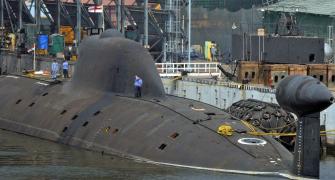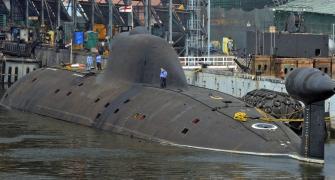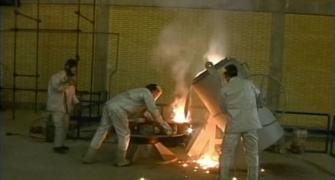Time and cost overruns are endemic to most Indian warship building projects.
A central reason is the Indian Navy's operational assessment that it is better to get a warship late and over budget than to get one that is technologically overmatched by potential adversaries.
Ajai Shukla reports.

When General Manoj Mukund Naravane, the chief of the army staff, commissioned Indian Naval Ship Kavaratti at the Garden Reach Shipbuilders and Engineers, Kolkata on October 22, it marked the end of Project 28 -- one of the Navy's most-ambitious, most-delayed, and most-budget busting warship projects.
Project 28, which envisioned building four indigenous anti-submarine corvettes, will end four years later than planned.
The ministry of defence approved it in 2003 and the first corvette was to be delivered in 2012, with the other three following at one-year intervals.
Project 28 has also overshot its budget by more than 250 per cent.
The project's sanctioned cost was Rs 2,700 crore, but will end up costing over Rs 7,000 crore.
Project 28 illustrates why time and cost overruns are endemic to most Indian warship building projects.
A central reason is the Indian Navy's operational assessment that it is better to get a warship late and over budget than to get one that is technologically overmatched by potential adversaries.
Project 28 also suffered significant delays because the navy insisted on indigenising each corvette to the maximum extent possible. Garden Reach Shipbuilders and Engineers told this correspondent that INS Kavaratti will have achieved an unprecedented indigenisation level of 90 per cent.
Delay began even before construction did, with the navy deciding that Project 28 corvettes would be the first Indian warships to be constructed from indigenous warship-grade steel.
The Steel Authority of India's Bhilai steel plant eventually developed the so-called DMR249A steel. But that involved a two-year delay.
Then, after INS Kamorta and INS Kadmatt -- the first two corvettes -- joined the fleet in 2014 and 2016, respectively, the navy ambitiously decided to build the remaining two corvettes's superstructures with composite materials to make them lighter and, therefore, faster.
In addition, warships built from composites reflect radar far less than steel, making them harder to detect.
This meant going to Kockums of Sweden for materials and to learn construction with composites, causing another year of delay.
On the positive side, this resulted in the weight of the third and fourth corvettes -- INS Kiltan and Kavaratti -- being reduced from 3,150 tonnes to just 3,000 tonnes.
These corvettes now cleave through the seas at a pacy 46 kilometres per hour and have a patrol endurance of 6,400 km at a speed of 33 kmph.
Further delay was caused because of the determination to indigenise as many systems and sub-systems as possible.
Vendors had to be developed even in the complex areas of sensors and weapons, where import content is usually high.
Garden Reach Shipbuilders and Engineers says INS Kavaratti will field a 76 millimetre Otomelara gun built by Bharat Heavy Electricals, while Larsen & Toubro has built its heavyweight torpedo tubes and rocket launchers.
Ordnance Factory, Ambarnath, manufactures the Kavach chaff launchers that serve as decoys for incoming missiles.
Bharat Electronics has built most of the sensors and combat management systems in INS Kavaratti.
Kirloskar Oil Engines has built the four diesel engines that power the Project 28 corvettes, while Cummins and Kirloskar Electric have engineered the 3 megawatt generators that supply electricity on board.
Remarkably, the expertise that Garden Reach Shipbuilders and Engineers and its sub-vendors have accumulated in designing and manufacturing a world-class anti-submarine corvette will now wither, since there are no more orders for such warships.
Instead, the navy is evolving a design for the so-called 'next-generation corvette'.
Major navies evolve a successful warship design and then achieve economy of scale by building them in large numbers, with only incremental changes to the basic design.
The US navy has built 82 destroyers of the successful Arleigh Burke-class and China is following the same approach with its latest Type 055 Rehnai-class destroyers.











